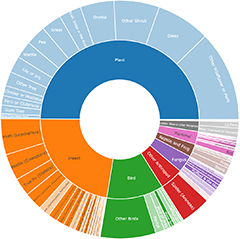Other Shrubs
Announcements
Hi All,We've just rolled out some important improvements to NatureMapr's sensitive data handling framework in consultation with the NSW Government Saving Our Species team.For Highly Sensitive records,...
Continue reading
Platform update continued 30 JAN 2025
Major upgrade under way. Some known issues.
Discussion
Hybridisation in Xanthorrhoea does indeed occur, and is likely to be widespread where different species converge, however it does not appear to occur as extensively as is believed, this is because it can only transpire under very particular environmental conditions, such as where two species have overlapping geographical distributions alongside a coincidental flowering period in conjunction with where they meet across a transitional zone comprised of a gradual environmental gradient. i.e. areas bounded by two ecosystems or an ecocline, for instance a region between clay and sandy soils or wet and dry habitats. Fundamentally these are always environments comprised of conditions not preferred by either parent.
Morphological intergradation can also occur when two or perhaps more species are found within close proximity of each other, and populations displaying intermediate characteristics between species may be interpreted as hybridisation but may be the result of lateral gene transfer, which is the transfer of genetic material between two organisms. Molecular and genetical analysis could prove the best means with which to resolve the taxonomic problems associated with this genus.
Xanthorrhoea resinosa
Really familiarly well known to me for over 35 years !
Xanthorrhoea minor subsp. lutea
Xanthorrhoea resinosa
Xanthorrhoea resinosa
Significant sightings
- Podocarpus lawrencei at Cotter River, ACT
- Lavandula stoechas at Hawker, ACT
- Tetratheca subaphylla at Kiah, NSW
- Hibbertia circinata at Kiah, NSW
- Boronia imlayensis at Kiah, NSW
- Prostanthera walteri at Jagumba, NSW
- Erica lusitanica at Nicholls, ACT
- Rhodamnia rubescens at Macquarie Pass, NSW
- Comesperma ericinum at Pialligo, ACT
- Tetratheca neglecta at Carrington Falls, NSW
Recent activity
Persoonia chamaepeuce at Brindabella, ACT
Epacris impressa at Freycinet, TAS
Macrozamia communis at Potato Point, NSW
Macrozamia communis at Potato Point, NSW
Epacris impressa at Freycinet, TAS
Lomatia myricoides at Brindabella, ACT
Top contributors
- Tapirlord 1.8K
- Mike 1.1K
- trevorpreston 881
- MichaelBedingfield 790
- BettyDonWood 701
- JaneR 623
- plants 597
- NedJohnston 473
- MatthewFrawley 443
- KylieWaldon 382
Top moderators
- Tapirlord 6.5K
- MichaelMulvaney 3K
- BettyDonWood 1.7K
- plants 1.5K
- natureguy 1.4K
- MichaelBedingfield 1.2K
- RWPurdie 440
- Mike 216
- Csteele4 215
- waltraud 208















































































































